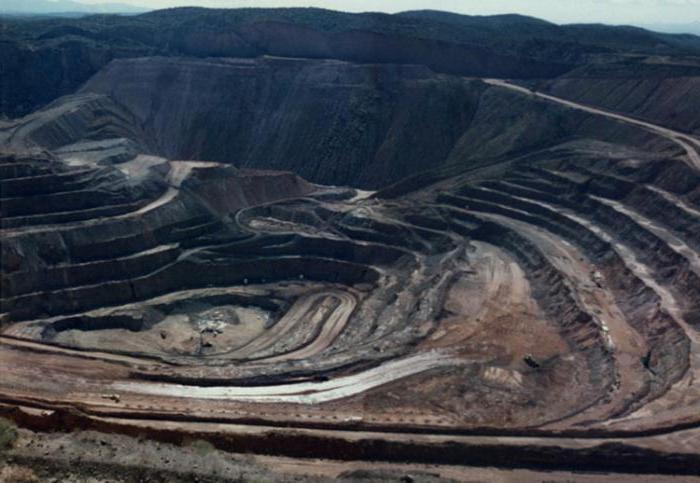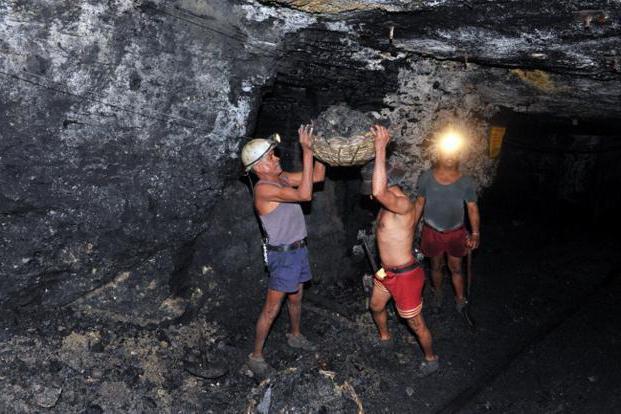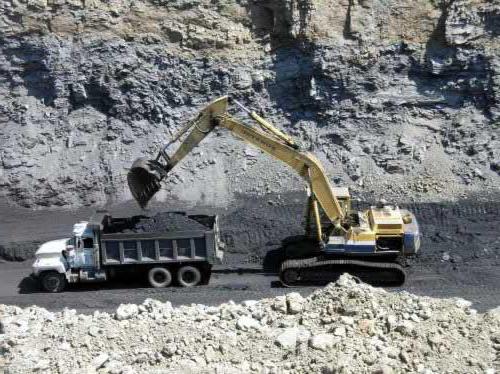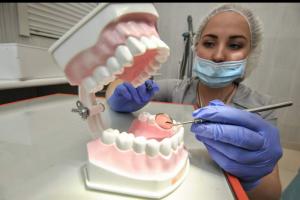Coal is the first fossil fuel that humans began to use. Currently, oil and gas are mainly used as energy carriers. However, despite this, the coal industry continues to play a crucial role in the economy of any country, including Russia.
Statistical data
In the 50s of the last century, the share of coal in the fuel and energy balance of Russia was 65%. Subsequently, it gradually declined. In particular, a serious decline began in the 70s, after the discovery of gas fields in Siberia. During the crisis of the 90s, the interest of power engineers in this type of fuel finally fell. Many hydropower plants, originally designed for coal, have been converted to gas.

In subsequent years, the production of solid fuel in our country increased slightly. However, the coal industry of Russia is developing, despite the current programs for its resuscitation, and in our time is pretty slow. In 2015, production in Russia amounted to about 360 million tons. At the same time, Russian companies purchased about 80 million tons. In Soviet times, even after the “gas break” that began in the 70s, this figure was 716 million tons (1980–82). Moreover, in 2015, according to representatives of the Ministry of Economic Development, investment in the industry also declined.
Coal industry: structure
There are only two types of coal mined: brown and stone. The latter has great energy value. However, coal reserves in Russia, as well as throughout the world, are not too many. Brown accounts for as much as 70%. Solid fuel can be extracted in two ways: open and mine. The first method is used when the distance from the earth’s surface to the seam is not more than 100 m. Coal can be mined at a very great depth - a thousand or more meters. Sometimes a combined development technique is also used.
In addition to enterprises engaged in the extraction of this type of solid fuel by mining and open pit mining, enrichment plants and briquetting plants are included in the structure of the coal industry. Natural coal, and especially brown coal, usually has a not very high calorific value due to the impurities contained in it. In processing plants, it is crushed and sieved through a net into water. At the same time, solid fuel itself floats up, and rock particles settle to the bottom. Then the coal is dried and enriched with oxygen. As a result, its thermal ability is significantly increased.
Briquetting, depending on the pressure indicators during processing, can be done with or without binders. This treatment significantly increases the combustion temperature of coal.
Main consumers
Coal is purchased from mining companies mainly in the fuel and energy complex, as well as in the metallurgical industry. Brown coal is used mostly in boiler houses. Also, sometimes it is used as fuel at a thermal power plant. Consumers of coal are mostly metallurgical enterprises.
The main basins of Russia
The largest coal basin in our country (and in the world) is Kuzbass. It produces 56% of all Russian coal. Development is carried out both by open pit and mine method. In the European part of Russia, the largest and most developed region is the Pechora coal basin. Solid fuel here is mined from a depth of 300 m. The pool's reserves are 344 billion tons.The largest deposits also include:
- Kachko-Achinsk coal basin. Located in Eastern Siberia and gives 12% of all Russian coal. Extraction is carried out in an open way. Kachko-Achinsky brown coal is the cheapest in the country, but at the same time the lowest quality.
- Donetsk coal basin. Mining is carried out by the mine method, and therefore the cost of coal is quite high.
- Irkutsk-Cheremkhovsky coal basin. Coal mining is carried out in an open way. Its prime cost is low, but due to the great distance from large consumers it is mainly used only at local power plants.
- South Yakut coal basin. Located in the Far East. Extraction is conducted in an open way.
Also quite promising in Russia are the coal basins of Leninsky, Taimyr and Tunguska. They are all located in Eastern Siberia.

The main problems of the coal industry in Russia
There are several reasons why the coal industry in our country is developing rather slowly. First of all, to the problems of this industry National economy include:
- protracted "gas pause";
- significant remoteness of production sites from major consumers.
Environmental pollution and the difficult working conditions of workers are also considered serious problems of the coal industry in modern Russia.
Gas or coal?
Thus, the coal industry of Russia is not developing particularly well primarily because of the consumer’s reluctance to switch from blue fuel to solid fuel. And no wonder. Gas in our country is very inexpensive. However, this problem of the coal industry is likely to be resolved in a rather short time. The fact is that the “gas pause” is close to exhaustion. According to Gazprom, it will last no more than 6-7 years. It is all about depleting the most cost-effective blue fuel deposits in Russia.
In this regard, programs aimed at developing the coal industry and introducing technologies based on the use of solid fuel throughout the entire production chain of the national economy are already being developed and are beginning to be implemented.

The problem of remoteness from consumers
This is perhaps the most serious problem of the coal industry today. The largest basin in Russia, Kuzbass, for example, is located 3,000 km from the nearest port. Large transportation costs lead to a decrease in the profitability of mines and opencasts and an increase in the cost of coal. The situation is aggravated by the rather weak development of railways in Eastern Siberia.
Of course, in the development programs of the coal industry, attention is also paid to this problem. One of the ways to solve it is the vertical integration of industry enterprises. It is proposed, for example, to organize small and medium-sized power facilities on the basis of mines. Such reconstruction can be carried out without special costs by installing turbine generators in mine boiler houses.
New coal enterprises engaged in the enrichment and briquetting of solid fuels can also be one of the solutions to this problem. Refined coal, of course, costs more than natural. And therefore, the cost of its transportation pays off faster.

Environmental problems
The development of coal seams, and especially in the open pit, negatively affects the environment. In this case, the problems may be as follows:
- landscape change;
- subsidence of the earth's surface and soil erosion;
- mine methane emissions;
- water and air pollution;
- coal burning in dumps and mines;
- rejection of land for storage of mining waste.
The solution to the environmental problem of coal mining may be, first of all, the adoption of a number of standards and laws governing all stages of mining.At the same time, enterprises should be encouraged to monitor their compliance at all stages of the development of coal seams.
Human health effects
Coal mining and seam development in densely populated areas of the European part significantly aggravates such problems:
- reduced life expectancy;
- an increase in the number of congenital malformations in children;
- increase in the number of nervous and oncological diseases.
These problems are especially relevant in the area of the Podmoskovny, Kachko-Achinsky and South Yakutsky basins. In this case, the solution to the problem can also be the development of various kinds of standards aimed at introducing new methods of organizing production, which help to maintain a clean environment.

Occupational diseases
The problems of the coal industry are actually numerous. However, occupational diseases are perhaps one of the most relevant. In particular, non-compliance with environmental production standards has an adverse effect on people working in mines. Production of this specialization is considered to be perhaps the most dangerous and harmful to health today.
Coal industry workers may be ill with the following diseases:
- pneumoconiosis;
- dust and chronic bronchitis;
- silicosis and koniotuberculosis;
- visual and auditory overstrain;
- neuropsychiatric pathologies;
- radiculopathy;
- arthrosis, cataract, vibration disease.
Pulmonary diseases occur as a result of coal miners inhaling coal dust and harmful gases. Visual and auditory overstrain occurs due to irrational lighting and difficult working conditions. The cause of neuropsychiatric diseases and radiculopathy is also usually overstrain. Vibration disease and arthrosis are primarily associated with the features of the coal mining process itself.
All sorts of norms harmful factors adopted in Russia for a very long time. And therefore, the solution to the problem of occupational diseases of workers in such an industry as the coal industry can only be strict adherence to them. Moreover, today the situation in terms of the development of occupational diseases of miners is extremely unfavorable. According to statistics, their level exceeds the industry average by 9 times.
Industrial injuries
The miner's profession, among other things, is also one of the most dangerous in the world. The coal seams being developed always contain a poisonous and explosive gas - methane. Any spark that appears during the operation of mine equipment can cause it to ignite. As a result of the explosion and subsequent collapse of the layers of coal, workers can not only get injured, but also die.
Industrial injuries for this reason can be prevented by improving the means of preventing the ignition of methane and coal dust. The development of protection systems should be based primarily on the automatic creation of explosive-blocking medium in mines. At workings, inhibitors of the methane oxidation reaction with oxygen should be sprayed. A gas-dispersed safety medium must be created continuously. Any hazardous explosion factors should be reduced to safe limits.
It is also necessary to ensure constant ventilation of the mines, to exclude the possibility of electric discharges, etc. Of course, the profession of a miner in this case will not become easier. But perhaps it will be much safer.
The problem of unemployment and its solution
Today, unprofitable mines are completely closed in Russia, as a result of which it was possible to get rid of the weak links in the production chain, which require, among other things, significant investments. Recently, the growth in profit of coal mining companies is also associated with the start of the development of really promising and profitable mines.The introduction of the latest technologies and equipment, however, caused the employment problem for residents of mining villages, as the need for manual labor decreased.

The Ministry of Energy and Coal Industry of Russia, we must give it its due, took this problem very seriously. All retired workers received good social protection. Many were given the opportunity to apply for processing enterprises in the coal industry. Indeed, with the increase in the production of solid fuels, their number also increased.
Prospects for the development of the coal industry in Russia
Enterprises engaged in the development of solid fuel beds in Russia can be really very profitable. The fact is that in our country there are many such deposits in which coal production can be carried out in a cheap open way. For example, the coal industry of Ukraine is currently not in the best condition, precisely because the seams in this country lie very deep. They have to be developed by the mine method. Ukrainian coal is several times more expensive than European, and therefore there can be no talk of competition.
In Russia, the coal industry is really promising. Its intensive development can be ensured only by further improving production technologies and reducing production costs.
To date, the priority areas of this sphere of the fuel and energy complex are:
- large-scale modernization of production;
- involvement in the processing of the most promising reserves;
- development of anti-crisis measures;
- reduction of costs for technical re-equipment of existing unpromising mines and opencasts.

Reserves and their characteristics
Thus, there are many worthy deposits of promising deposits in Russia. The Pechora coal basin, Kuzbass and other workings are capable of providing the country with solid fuel for centuries. Coal reserves in our country exceed 4 trillion tons. That is, with the current production of 300-360 million tons per year, resources will be enough for about 400 more years.
Coal basins in Russia are numerous, and seams are available for development. The development of the latter has practically no restrictions. In addition, the solid fuel produced in our country in most cases has very good qualities, and therefore is valued on the European market. Coal, whose characteristics are higher than that of Russian, is supplied only from North America and Australia.
Conclusion
Thus, the main task of the innovative development of the coal industry in Russia are:
- increase production safety;
- introduction of new technologies for coal processing;
- vertical integration of the coal industry.
Determining the policy and development prospects of the coal industry, it is necessary to form an effective mechanism of state regulation, as well as to develop a system of economic measures conducive to the active movement of investments. In addition, a set of organizational and legislative measures should be adopted aimed at harmonizing the structure of the state’s fuel and energy balance and ensuring outstripping growth in coal consumption mainly at CHP plants.








